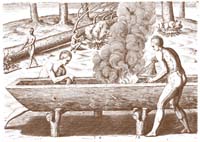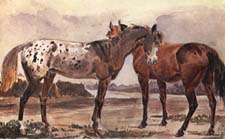
 |
Indians of the Secotan tribe hollowing out a log with fire and scraping tools to make a dugout canoe. (engraving by Theodor de Bry, 1590) |
The most vigorous trees that one sees there are a species of cotton-tree, of extraordinary girth and height. The savages therefore use these trees for making canoes,--all of one piece, fifty feet in length and three in width, in which thirty men with all their baggage can embark. (Claude Dablon, 1674)![]()
Prior to the introduction of the horse, the Illinois traveled either by walking or by floating in rivers using dugout canoes. Dugouts were made from the trunks of cottonwood (Populus deltoides) trees, which were cut down and hollowed out using stone axes and controlled fires. The dugouts, called "pirogues" by the French, were very heavy and the Illinois propelled them with poles rather than paddles. Each household had as many as three dugouts. They were useful for hauling heavy loads, including hunting parties bringing home game animals, and households moving from their summer villages to their winter villages.
![]()
Horses at St. Louis. (watercolor by Rudolf Friedrich Kurz, 1848)
Horses are not native to North America. Spanish explorers brought them to the New World in the 1500s, and began breeding them at stock-raising settlements in what is now the southwestern United States in the early 1600s. The Apache began raiding these settlements for horses in the 1650s, and traded them northward and eastward to tribes living in the Great Plains. The Pawnee, Wichita, and Missouri tribes had obtained horses by 1700, and they reached the Kaskaskia Illinois by 1711. The Kaskaskia initially used horses as draft animals to power grist mills they operated for grinding corn. However, as the supply increased, horses became an important means of transportation.![]()
|
|
Copyright © 2000 Illinois State Museum
